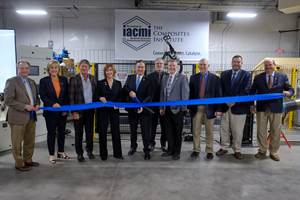Knowledge and experience
CW Editor Jeff Sloan reflects on experiential knowledge after a recent IACMI event reception hosting member company interns.
It’s mid-August as I write this and throughout the United States students are either heading back to school, or preparing to do so. Indeed, just three days ago my oldest son packed his belongings into his car and departed for two years of graduate school in Los Angeles. Similarly, tomorrow my wife and I will pack up my youngest son and his belongings and deliver him to his dorm room and his first year of college. Finally, just more than a month ago, my second son, who graduated from college in May, landed his first full-time, salaried job and is busy learning what it means to be a fully functional adult.
My wife and I, of course, are among millions of parents going through the same or similar separations this month. We follow millions of parents who have preceded us, and behind us is another generation of parents who can only imagine (dread) such a day. Regardless of where you fall on the parenthood timeline, one of the biggest, universal, unwritten goals of the job is the development of children who are emotionally and intellectually equipped to leave home and enter the world — to pursue education, knowledge, career, identity, fame, fortune, etc.
As I watch my own children enter the workforce and pursue various levels of higher learning, I can’t help but consider the education/experience dichotomy they face — that each of us has faced at one point. The dichotomy is this: Imparting knowledge, in whatever setting, always has been and remains a valuable instrument of societal evolution and advancement. We rely on our educational institutions to pack our kids’ brains with the stuff they need to pursue a career or interest, whether that be engineering, medicine, law, business or composites. We also rely on our educational institutions to instill in our kids the ability to develop habits of ongoing learning that allows them to grow and adapt as the work world grows and adapts.
But no matter how many classes and courses our kids take, and no matter how much they read and understand, they cannot be fully educated without experience. We have no way of fully transferring experience. We cannot pack years of trial, error, false starts, failure, success, experimentation, joy and dejection into a college course. This experiential knowledge only comes with actually putting in the time — a lot of time.
This hit me particularly hard in July at the Institute for Advanced Composites Manufacturing Innovation (IACMI) summer meeting in Knoxville, TN, US. At a reception one night, the IACMI staff gathered the 40+ college interns who were spending the summer at various IACMI member companies together for a photo. I had talked to a few of these students earlier in the evening and I found them eager, smart and curious.
As I watched them pose for the photographer, I thought also about the other people at that reception — the “veteran” engineers and officials representing almost every ilk of the composites supply chain, from materials manufacturers to fabricators to OEMs. The collective experience of this group — spanning decades — represents an accumulated composites history that is likely without rival anywhere in the world. How wonderful would it be, I thought, if you could transfer the experiential knowledge of composites veterans into these young minds before me, just entering the composites industry.
This is, of course, a conundrum faced by every human-based organization ever created, and we are not helpless to solve it — there are ways to close the experience gap. We can pair young employees with mentors, or carefully document events and systems to create an easily referenced history. Such things, however, require a foresight and investment of treasure that most companies and organizations simply cannot muster.
The ultimate solution to this problem might come in the form of machine learning, but until that comes to fruition, I suspect we are left with the age-old method of simply putting in the time and the work. Which is not such a bad thing. There is a rewarding sense of exploration and discovery that comes with experiential learning that can give our work meaning. In that spirit, I certainly hope my own children discover for themselves an experience that lasts a lifetime.
Related Content
IACMI receives funding renewal from U.S. DOE to continue composites R&D
Over the next five years, IACMI aims to further composites R&D efforts to support U.S. decarbonization and its pillars: technology, economy and workforce development.
Read MorePeople in composites: April 2023
Concordia Engineered Fibers, Nawa Technologies, IACMI, Joby Aviation and Akarmak America have made new personnel announcements in April 2023.
Read MoreRead Next
“Structured air” TPS safeguards composite structures
Powered by an 85% air/15% pure polyimide aerogel, Blueshift’s novel material system protects structures during transient thermal events from -200°C to beyond 2400°C for rockets, battery boxes and more.
Read MoreDeveloping bonded composite repair for ships, offshore units
Bureau Veritas and industry partners issue guidelines and pave the way for certification via StrengthBond Offshore project.
Read MoreAll-recycled, needle-punched nonwoven CFRP slashes carbon footprint of Formula 2 seat
Dallara and Tenowo collaborate to produce a race-ready Formula 2 seat using recycled carbon fiber, reducing CO2 emissions by 97.5% compared to virgin materials.
Read More













.jpg;maxWidth=300;quality=90)






